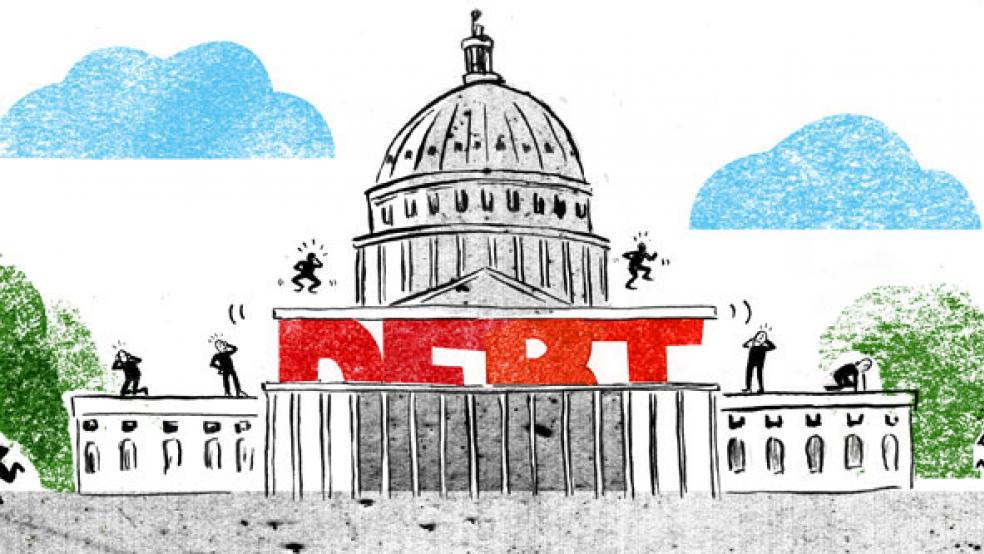The Treasury Department has suspended investments into federal employees' pensions, as the government officially hit its debt ceiling of about $18.1 trillion on Monday.
The law allows the government to take “extraordinary measures” to avoid a default, including tapping into and suspending investments into the Civil Service Retirement and Disability Fund and halting the daily reinvestment of the government securities (G) fund, the most stable offering in the Thrift Savings Plan's portfolio.
Halting the daily reinvestment into the TSP’s G Fund temporarily will free up about $195 billion in “headroom” under the limit - the fund’s current balance, according to Treasury. Tapping the CSRDF gives Treasury about $20 billion in headroom over the next three months.
Related: The Federal Debt Is About to Become a Big Issue Again
The law requires the Treasury secretary to refill the coffers of the G Fund and the Civil Service Retirement and Disability Fund once the issue of the debt ceiling is resolved and to make up, in addition, for any interest lost on those investments during the suspension. So, there is no effect on federal employees and retirees but things could get dicey if the government exhausts its wiggle room and runs out of cash.
“Protecting the full faith and credit of the United States is the responsibility of Congress, because only Congress can extend the nation's borrowing authority,” said Treasury Secretary Jack Lew in a March 13 letter to Congress announcing debt issuance suspension period beginning March 16. “No Congress in our history has failed to meet that responsibility. The creditworthiness of the United States is not a bargaining chip, and I again urge Congress to address this matter without controversy or brinksmanship.”
The Congressional Budget Office estimated that Treasury will run out money in October or November if Congress does not increase the debt ceiling before then. CBO noted that the government typically runs a large surplus in April when income taxes are due, which allows some extra time. That, as well as the extraordinary measures “should allow the Treasury to finance the government’s normal operations for several months without an increase in the debt ceiling,” the office stated in an analysis of the current situation.
Related: Balanced Budget Goal Means Furious Battle Ahead
But if the government's alternative financing options are exhausted, and Treasury runs low on cash before a new debt limit is agreed upon, “there could be delays in honoring checks and disruptions in the normal flow of government services,” a 1995 CBO report stated.
That has never happened. But if it did, it would have serious economic consequences and possibly result in furloughs for federal employees.
There is no clear roadmap for agencies or federal employees to follow if Uncle Sam cannot pay his bills, making the situation much less predictable than, say, a government shutdown.
The services and benefits that a default would adversely affect, could include:
- Military pay and retirement benefits
- Federal civil service salaries and retirement benefits
- Veterans' benefits
- Social Security and Medicare benefits
- Payments to defense contractors
The 2014 Temporary Debt Limit Extension Act suspended the debt ceiling, which is about $18.1 trillion, through March 15, 2015. The last time the government hit the limit and Treasury tapped the G Fund was in February 2014, right before lawmakers passed the Temporary Debt Limit Extension Act. Sen. David Vitter, R-La., introduced legislation in January that would limit Treasury’s ability to tap the Civil Service Retirement and Disability Fund and G Fund to buy time to avoid a default. That bill is still in committee.
Related: 106 Radical Ways to Slash and Burn the Federal Budget
In 2011, Congress and the Obama administration had contentious fights over raising the debt limit, leading to the 2011 Budget Control Act. That law suspended the ceiling - and the battles over it - until 2013. It also created the automatic, governmentwide budget cuts known as sequestration, which began in 2013 and will return to full force on Oct. 1, 2015, unless Congress acts.
This article originally appeared in Government Executive.
Read more at Government Executive:
Unlocking the Secret of FERS
A Critical Part of Planning, by Any Estimation
You've Invested for Retirement. Now What?




